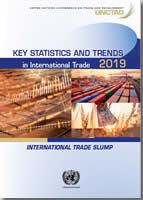
After a recovery in international trade in 2017 and the first half of 2018, economic conditions started deteriorating in the second half of 2018 and further in 2019. The reasons were trade tensions between the United States of America and China, fears of a disorderly Brexit in Europe and a negative global output outlook more generally. Preliminary data for 2019 indicate a sharp decline in trade growth to negative 3 per cent. This most recent trend would make target 17.11 of the Sustainable Development Goals more difficult to achieve.
Similar to the trade downturn of 2015 and 2016, negative trade growth coincides with positive growth in global output. But projections indicate that the current episode—triggered by prolonged trade tensions between major economies and more generally by the weakening of multilateralism—is unlikely to be followed by a swift recovery, as it was observed in 2017 and 2018 due to commodity prices rebound and a growth in volumes backed by solid output and investment growth.
In contrast with 2019, trade growth of 2018 has been widespread to include most goods and services sectors. Merchandise trade has shown a particularly strong increase while services trade increase was more gradual. Trade in agricultural goods and natural resources showed the strongest value growth in 2018 because of higher prices, while manufactured goods trade growth was more modest. The trade surge of 2018 also affected positively all geographic regions. South–South trade has recovered above its 2014 levels.
This report is structured into two parts.
The first part presents an overview of the status of international trade using preliminary statistics up to the third quarter of 2019.
The second part provides illustrative statistics on international trade in goods and services covering the last decade. The second part is divided into two sections. Section 1 provides trade statistics at various levels of aggregation illustrating the evolution of trade across economic sectors and geographic regions.
Section 2 presents some of the most commonly used trade indicators at the country level, to illustrate trade performance across countries.


